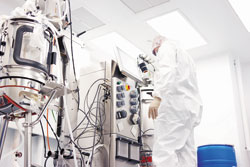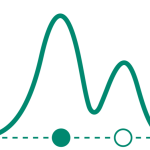
By Bruce Lehr, Delia Lyons
Quality, flexibility, and cost savings are driving use of perfusion technology in biosimilars manufacturing.
Cell-culture technology for biopharmaceutical manufacturing has steadily advanced over the past three decades. Batch processing, in which all raw materials are introduced into the bioreactor at the beginning of the cell-culture process, have largely been replaced with fed-batch systems, in which additional nutrients are added to maintain longer culture times. Now, improved continuous culture technologies such as perfusion are on the rise, as biosimilar manufacturers look for new ways to cut costs while increasing quality and productivity.
With perfusion technology, fresh medium is continuously introduced while spent medium, which generally contains the API and waste products, is removed. Cells are retained in the bioreactor by a device such as an alternating tangential flow (ATF) filter. If specific productivities are kept high, higher cell concentrations (generally, greater than 100 x 106vc/mL) can be attained resulting in greater volumetric productivity (more than 1.5 g/L day). Increased productivity can allow biosimilar manufacturers to achieve flexibility with a smaller facility footprint, and enable them to adapt operations for multiple products (1).
Perfusion was first introduced in the 1980s to enable the production of sensitive proteins that degraded when left in bioreactors under batch and fed-batch conditions. Around the same time, continuous processing was first recognized as a potential way to attain higher productivity than could be achieved via batch and fed-batch processes.
Equipment limitations, such as the lack of good aseptic connectors, marginal pump accuracy, and inadequate on-line monitoring, led to technical problems and regulatory uncertainties. There were questions about how to validate these processes, and how to define a batch that was produced under continuous operation (2).
Dramatic increases in the titers achievable with fed-batch culture, which reached levels as high as 4.7g/L (3), eventually eliminated the need to pursue continuous processing for increased productivity. By the early 2000s, perfusion was largely used to manufacture only products such as recombinant blood-clotting factors and enzyme treatments for rare metabolic storage disorders such as Fabry’s disease, which are unstable in fed-batch systems. Perfusion is also used for biologics that are toxic to the producing cell line and cannot be produced under fed-batch conditions (4).
Within the past decade, however, changes in the biopharmaceutical industry and advances in perfusion technology have increased its rate of adoption. Many drugs have or will soon come off patent, increasing pressure on manufacturers to reduce costs. The biosimilars market is growing at a healthy rate (5), yet it is also extremely competitive.
Many manufacturers of branded biologics are shifting their focus from blockbusters to smaller-volume, targeted therapies such as orphan drugs. These drugs are often produced in smaller, more flexible facilities that are designed to manufacture multiple products, and often involve the use of disposable equipment. Biosimilars manufacturers are seeking technologies that can provide measurable competitive advantage.
Continuous benefits
Continuous cell-culture processes (i.e., processes such as perfusion, that often operate continuously for 30-100 days) offer several advantages over more discrete traditional batch and fed-batch systems, which run for about 10-14 days. Constantly removing the product from the bioreactor reduces the retention time of the protein, a key improvement under production conditions that facilitate aggregation and degradation of the biologic active ingredient. In addition, the shorter retention times and more consistent conditions achieved at steady state provide more homogeneous product quality attributes (6).
Because of higher volumetric productivities, smaller bioreactors (i.e., 2000 L rather than 20,000 L) are more typically used for perfusion processes. The use of smaller bioreactors, even for commercial production, reduces the time and cost required for scale-up (7). Finally, perfusion can accommodate the shift toward multiproduct facilities, which often have different yearly production requirements (e.g., blockbuster versus orphan drug) while using the same size bioreactor, simply by running it for a longer or shorter culture time at steady state.
Similarly, changes in market demand can be met more rapidly, while use of disposable equipment reduces capital investment, cleaning and validation costs, as well as equipment footprint. Perfusion is also compatible with disposable technologies.
When to use perfusion
Because fed-batch systems have been better known and are more familiar to date, many companies use them rather than perfusion systems. The exception has largely been production of sensitive proteins that degrade under fed-batch conditions. In some cases, perfusion has also been used to meet product quality targets such as N-glycan or sialylation profiles.
Today, numerous branded biologic and biosimilar companies are exploring the use of perfusion technology, often in conjunction with disposable equipment, to save costs. Notably, much higher peak cell densities (higher than 100 million cells/mL) can be achieved in perfusion than through fed-batch systems, and these high cell densities can be maintained for extended periods (i.e., from 30 to more than 100 days), resulting in higher product yields.
Perfusion processes are also seen as better suited to meet the needs of flexible, often single-use, multiproduct manufacturing facilities. Such manufacturing sites generally have smaller reactors and are faced with the challenge of preventing cross-contamination. Regulatory agency interest in the greater process control and product consistency afforded by continuous manufacturing (8) is also generating more attention around perfusion technology.
As perfusion process performance has improved, it has become increasingly possible for biopharmaceutical manufacturers to realize efficiency improvements. Notably, because of the sophistication and efficacy of the controls used for all aspects of perfusion processes, such as pumps with feedback control or advanced in-line and on-line analytical tools, it is now possible to monitor many of the key parameters that influence cell culture performance. Contamination issues have also been significantly reduced with the development of aseptic connections.
Cell separation devices have also become more efficient, allowing for very high cell densities to be achieved. It should be noted, however, that further developments in this area are needed, because it can be technically challenging to work with the extremely high densities obtained in intensified perfusion.
Furthermore, protein retention has been reported when working at high densities with filtration systems. Manufacturers have access to more sophisticated media and more stable cell lines with new selection technologies that eliminate the need to use expensive selection agents that are required for selection agents such as the aminoglycoside, geneticin (G-418), 1-methionine sulfoximine (MSX), methotrexate (MTX), or puromicin. Once the selection pressure is removed, those cell lines tend to lose expression (9). The use of a glutamine synthetase (GS) system maintains the selection pressure having to add an agent.
Importance of media
While significant advances have been made in cell-culture media, there remains a need to optimize modified media for use in intensified perfusion processes. These media should be able to maintain the highest possible viabilities, cell densities, and specific productivities with the desired product quality at the lowest possible perfusion rates to minimize media consumption. Traditional media are not designed to overcome the buildup of toxins that can occur at these lower, cell-specific perfusion rates. Media designed for such perfusion processes must include not only a higher content of specific nutrients to maintain maximum performance, but also a modified balance of other nutrients to provide improved waste management.
Access to media designed specifically to address these needs is expected to have a significant impact on the adoption of perfusion in general.
The use of specialized media will lead to a measurable reduction in the cost of goods for drug production, with the added advantages inherent in perfusion of greater process consistency and improved product quality. As a result, the performance advantages of perfusion will be much greater than those of fed-batch. Once there is widespread recognition of these additional advantages of continuous cell culture, more branded biologic and biosimilar companies will likely select perfusion manufacturing for at least some of their processes.
Perfusion support
One of the challenges faced by all companies that are exploring use of perfusion processes is the limited ability to use high-throughput methods in perfusion mode. Currently, there is no perfusion device that can handle the working volumes typically used for high throughput techniques (1-200 mL). Industry efforts are underway to find alternative models that will extend the applicability of high-throughput methodology to perfusion to accelerate the media development workflow applied during custom projects (10,11).
While perfusion technology has been available for more than 30 years, it has been only in the past few years that branded biopharmaceutical and biosimilar manufacturers have expressed serious interest in its potential for biologic API production. Continuous cell culture offers many advantages, but in the end, for any given biotherapeutic, the choice between perfusion or fed-batch processing ultimately comes down to cost, if comparable product quality can be achieved using either technology. As a result, fed-batch is often preferred in existing plants with installed capacity, whereas in newer, multiproduct facilities, perfusion in single-use equipment provides favorable economics.
References
Feliza Mirasol is the science editor for BioPharm International.
Article Details
1. D. Davis et al., “Modeling Perfusion for Medium Component Optimization Using ambr®15,” Presented at Cell Culture Engineering XV, Palm Springs, CA, 2015. 2. J. Karpinski et al., Biotechnology and Bioengineering 102 (4):1182-96 (2009).
3. B. Kelley, MAbs 1 (5): 443-452 (2009).
4. K. Konstantinov and CL Cooney, White Paper on Continuous Biopprocessing, Continuous Manufacturing Symposium, Journal of Pharmaceutical Sciences 104:813-820, May 20-21, 2014.
5. C. Challener, “Focus on Biosimilars,” PharmTech.com, October 6, 2014.
6. E.S. Langer and R.A. Rader RA, Bioprocessing Journal 13 (1): 43-49 (2014).
7. D. Lyons et al., “Modeling Perfusion at Small Scale Using ambr15,” presented at Integrated Continuous Biomanufacturing II, San Francisco, CA.
8. J. Woodcock, “Introducing New Technology in Pharmaceutical Manufacturing,” presented in Integrated Continuous Manufacturing II, San Francisco, CA, 2015.
9. J. Pollock, et al., Biotechnology and Bioengineering 110 (1): 206-219 (2013).
10. J. Walther et al., “Delivering Steady-State Product Quality with an Intensified And Integrated Perfusion Cell Culture Process,” presented at Integrated Continuous Biomanufacturing II, San Francisco, CA, 2015.
11. F.M. Wurm, Nature Biotechnology 22: 1393-1398 (2004).





